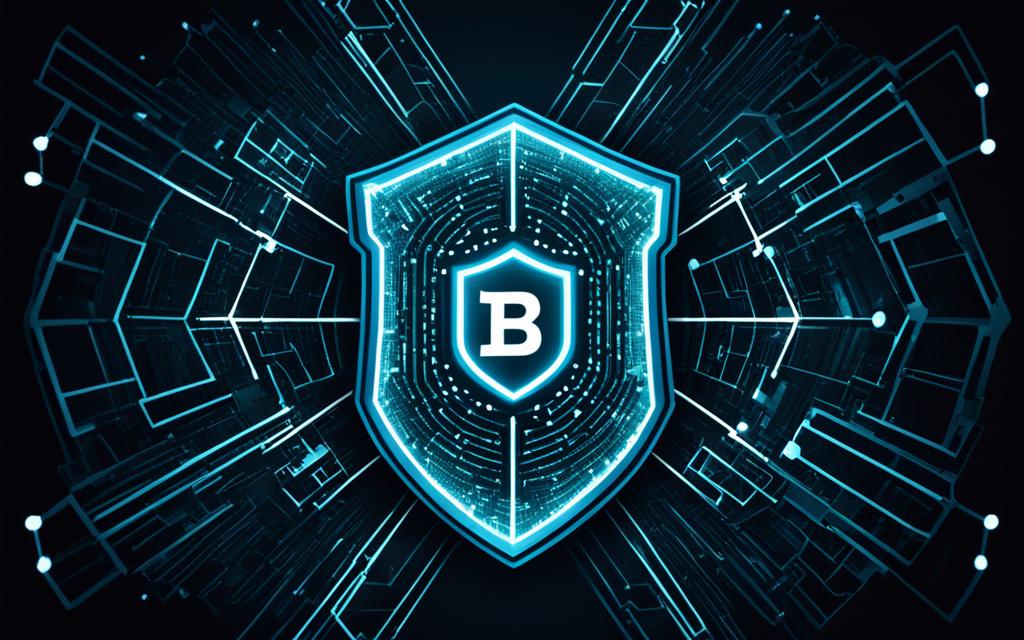Table of Contents
In the blockchain world, a hash is key. It’s like a digital fingerprint for data. This unique code is made by a special math process that turns data into a string of characters. This makes sure no one can change the data without us knowing.
There are many ways to create these hash codes. Some popular methods are SHA-256, MD5, RIPEMD-160, and CRC32. Each method has its own way of showing the security level of the hash.
Key Takeaways
- A hash code serves as a digital fingerprint, providing a unique identifier for data within a blockchain12
- Hash functions, such as SHA-256 and MD5, generate hash values that verify the integrity of data12
- Blockchain technology relies on cryptographic hash functions to ensure data authenticity and prevent tampering12
- Hash functions play a critical role in securing transactions, validating blocks, and creating wallet addresses in blockchain systems12
- Popular cryptographic hash functions include SHA-256, RIPEMD-160, and CRC32, each offering specific security features12
What is a Blockchain Hash?
A blockchain hash acts like a fingerprint for digital documents. It ensures data is secure and hasn’t changed. This is key for blockchains to work well and keep information safe. A hash is made using a special math method that checks new data against an old hash. If they match, the data is safe. Changing the data in any way will create a different hash, showing that the data has been tampered with2.
Adding a hash to the chain happens when new data is checked. If the data in the block changes, the hash does too. This means a quick look at the hash can show if data has been tampered with. It makes blockchains very safe, stopping people from changing data without others knowing23.
The SHA-256 method is often used for making hashes in blockchains. The NSA created this method. It makes very long and hard-to-guess hashes. This makes data very secure in blockchain systems4.
Hash functions are not just for money systems like Bitcoin. They’re also used in many other areas. For example, they help check if book codes are right without showing the book details. This is a big help in keeping data safe in different digital ways2.
Hashing is also important in how new Bitcoins are made. Miners check data and try to find a special hash. This hash shows they did their job right. It’s a tough task and uses a lot of energy. Miners work by trying lots of different hashes until they find the right one. This makes sure the Bitcoin system is safe and fair for everyone2.
Blockchains depend on hash functions to protect data. Hashes help make sure information is exact and not changed. They play a big part in how trustworthy and secure blockchains are for all users23.
| Benefits of Blockchain Hash | Examples |
|---|---|
| Ensures data integrity | Cryptocurrencies like Bitcoin, Ethereum, Litecoin |
| Provides immutability | Multi-factor authentication systems |
| Enhances security | Supply chain management |
| Facilitates secure transactions | Document verification systems |
Blockchain Hash Applications
- Miner verification and block validation2
- Cryptocurrency transactions and wallets4
- Document and data verification3
- Supply chain management and traceability3
- Smart contracts and decentralized applications3
Types of Hash Functions in Blockchain
Hash functions are key in Blockchain. They secure data and make operations efficient. In Blockchain, you find many hash functions like SHA-256, MD5, and more.
SHA-256 is very popular in Blockchain5. It creates a 256-bit hash, good for checking file validity. This is important in fields such as finance and healthcare.
MD5, though, gives a 32-character hash. It’s used to check if data got changed5. But, it’s known to have some weaknesses with data integrity5.
RIPEMD-160 is great for making secure key pairs5. It gives a 20-character hash. This strengthens the security in key-based activities.
CRC32 helps find accidental data changes5. It has different fixed bit lengths, like 32-bit or 256-bit6. This is crucial in keeping data accurate.
Tiger Algorithm is an improved way to hash data5. It’s faster and more secure than MD5 and SHA algorithms. With a 192-bit capability, it boosts data security in Blockchain work.
Tiger Algorithm Features
| Hashing Algorithm | Hashing Capacity | Advantages |
|---|---|---|
| Tiger Algorithm | 192 bits | Fast and Efficient Processing |
By using these hash functions in Blockchain, data safety gets a big lift5. They check data is right, speed up info finding, and secure how data is shared5.
Remember, hash functions are crucial for many data tasks. They help extract and remember digital marks. They also make sharing data safe5.
In summary, the variety of hash functions in Blockchain do a lot. They help keep data solid and safe. Plus, they make Blockchain run better.
Importance of Hash Functions in Blockchain Security
Hash functions are key in keeping data safe in Blockchain technology. They help make sure data is true, check it’s real, and control how quickly we can get it.

Think of blockchain hash functions like digital fingerprints. They create unique marks for each piece of data. These marks let us spot if anyone has tried to change the data.
The RIPEMD and MD families are popular in Blockchain for keeping data safe7. There’s also the BLAKE2 method, which is better than some older ones. BLAKE3 works even faster and has cool new features7. Whirlpool makes a very strong 512-bit hash to protect data too7.
SHA-256 from the SHA family is widely used because it’s very secure7. Earlier, SHA-1 was used, but problems made experts develop new SHA-2 types. Later, SHA-3 became the top choice in 20127.
| Hash Function | Common Use | Hash Length |
|---|---|---|
| SHA-256 | Blockchain integrity verification | 256 bits |
| MD5 | File and data set integrity validation | 128 bits |
| RIPEMD-160 | Data integrity verification | 160 bits |
| CRC32 | Error-detecting code | 32 bits |
| Tiger | Efficient hashing | 192 bits |
Using many hash functions together boosts blockchain security8. These functions are very important for keeping blockchain data safe and true. They help with things like signatures and checking how data is changed over time7.
Also, hash functions help manage how quickly we can get data. This makes the whole blockchain system work better and more smoothly8.
As blockchain grows, keeping data secure and real is crucial. Hash functions do this job well, making sure we can trust the data we use. This helps with safe deals, checking signatures, and keeping secrets safe.
Use Cases of Hash Functions in Blockchain
Hash functions are key in blockchain, performing critical roles. They help with data extraction, data retrieval, digital signatures, Merkle Tree, and Proof of Work consensus. This makes them very important. Now, let’s dive into how hash functions are used in the blockchain world.
Data Extraction and Retrieval
In blockchain, hash functions make data extraction and retrieval quick and easy. They change data into numbers, making it easier to find what you need. This speeds up searching for specific data, making using blockchains smoother for everyone1.
Digital Signatures
For blockchain transactions to be safe and real, digital signatures are essential. Hash functions help create and check these digital signatures. They turn each transaction into a unique code. This code, along with the user’s private key, makes sure transactions are safe, stopping anyone from changing them9.
Merkle Trees
Merkle Trees use hash functions to protect block headers in blockchain. They connect different transactions by using hash values. This lets users quickly spot if any transaction has been changed. It keeps the blockchain’s history accurate and safe9.
Proof of Work Consensus
When it comes to mining in blockchain, Proof of Work relies heavily on hash functions. Miners try to find a special hash value. This hard work ensures every new block is safe and correct. Miners check many hash values until they find the right one. Hash functions in this case make blockchains stronger and unchangeable9.
These examples show how vital hash functions are in blockchain. They do more than just one job, making blockchain more secure, fast, and trustworthy.
How Hash Functions Work
Hash functions are key in blockchain technology. They change long strings into short ones. This makes data secure and keeps the ledger safe10.
For encryption, hash functions like SHA-256 are vital. They turn any input into a set-length code. This means the encrypted data is well-protected11.
Hash functions need to be special for blockchain. They should stop the same output from two inputs. This stops anyone from changing the blockchain’s truth10.
The way hash values are made is quite complicated. It involves steps like starting with certain numbers, breaking down data, and mixing it. Despite these many steps, the output is always the same for a given input. This predictability is a key feature11.
In blockchain mining, hash functions set the challenge. Miners adjust a nonce to match a target in the hash. This ensures adding new info to the blockchain is not easy11.
Security is crucial for hash functions in blockchain. If a hash is weak, the blockchain could face attacks. This is risky, especially with new tech like quantum computing10.
Overall, hash functions do a lot for blockchain. They keep data right, help create digital signatures, and support consensus methods. This makes them key for safe and trusted blockchain networks10.
Detailed Encryption Process with Hash Functions
| Step | Description |
|---|---|
| 1 | The input data is transformed into binary. |
| 2 | The hash function initializes constants required for the encryption process. |
| 3 | The data is chunked into manageable sections for computation. |
| 4 | A message schedule is established to process the chunks of data efficiently. |
| 5 | A compression loop is performed, iteratively modifying the intermediate hash values. |
| 6 | The final values are adjusted, and the hash output is generated. |
This detailed process helps hash functions make data secure in blockchain.
Importance of Hashing in Blockchain Technology
Hashing is vital for blockchain’s security. It ensures blocks maintain their integrity and keeps data secured. It’s instrumental in checking data consistency and securing digital signatures.
“Bitcoin primarily uses the SHA-256 (Secure Hash Algorithm 256-bit) hashing algorithm”12.
“Litecoin utilizes the Scrypt hashing algorithm, known for its memory-intensive nature”12.
Hash functions help stop fraud and double-spending in blockchains. They verify that data is genuine, which is key for blockchain security.
-
Bitcoin primarily uses the SHA-256 (Secure Hash Algorithm 256-bit) hashing algorithm12.
-
Litecoin utilizes the Scrypt hashing algorithm, known for its memory-intensive nature12.
Miners face the hash problem in cryptocurrency mining. They aim to find a hash value equal to or less than the target hash the network sets.
“SHA-256, a cryptographic hash function widely used in blockchain, produces a fixed-size 256-bit hash value for enhanced security”13.
Every blockchain node compares hash values. This is crucial to check if new blocks are valid, maintaining the trust in the system.
“Merkle Trees in blockchain utilize hashing to efficiently organize transactions, reducing data storage needs and enhancing network scalability”13.
Hashing ensures data’s immutability, making it a central element in blockchain security. This irreversibly signs and secures every block.
“The SHA-256 hashing algorithm, developed by the NSA in 2001, is extensively used in blockchain technology”14.
| Hash Function | Description/Features | Reference |
|---|---|---|
| SHA-256 | A cryptographic hash function widely used in blockchain. Produces a fixed-size 256-bit hash value for enhanced security. | 13 |
| Scrypt | A hashing algorithm known for its memory-intensive nature. Used by Litecoin. | 12 |
| Merkle Trees | Utilizes hashing to efficiently organize transactions, reducing data storage needs and enhancing network scalability. | 13 |
| SHA-256 | The SHA-256 hashing algorithm, developed by the NSA in 2001, is extensively used in blockchain technology. | 14 |
Hash Functions and Blockchain Applications
Hash functions are key in Blockchain tech. They are great for storing data, ensuring always real messages, and confirming if data is real.
Data Storage
In Blockchain, hash functions help keep data in check. They turn big data bits into fixed-size hashes. This makes storing and finding info quick and easy. Searches in lists and arrays speed up thanks to hash conversion1.
Message Integrity
Keeping messages safe is a top priority in Blockchain. Hash functions spot any tampering by giving each message a unique hash. This method serves as a digital seal, protecting messages from changes1.
Authenticity Verification
Proving authenticity in Blockchain is vital. Hash functions compare files to see if they are a match. This check boosts the safety of data moving around in Blockchain networks5.
Secure Transactions
Hashes help make transactions in Blockchain very secure. Each transaction gets its own hash. This step makes sure money or deals are handled safely within Blockchain1.
Blockchain Mining
Hash functions are crucial for Blockchain mining. Miners must find a hash that meets the network’s criteria. This effort helps keep Blockchain secure and spread out1.
Digital Signatures
For Blockchain, hash functions also work in digital signatures. They make sure transaction info is intact and from the right sender. This use increases trust in Blockchain transactions5.
Merkle Trees
Merkle Trees use hash functions to secure block and transaction data. They arrange hashes in a tree. This method helps keep all data unchanged and supports Blockchain’s decentralised design5.
Hash functions are crucial for Blockchain’s many perks. These include good data storage, safe messages, and real data checks. This importance helps make Blockchain work well and safe.
Conclusion
Hash functions are key to blockchain technology. They give data a unique digital mark to spot if it’s been changed. The SHA-256 is a top hash function for its strong security15. Types like SHA-256, MD5, and RIPEMD-160 are good for keeping data safe thanks to their special features. These include being fast, hard to crash, and tough to break into15.
For understanding data structures and algorithms, learning about hashing is crucial15. Hashing keeps data safe by creating special IDs. They show if data has been altered and keep it secure and true15. In cybersecurity, it’s used for things like storing passwords and blockchain tech15.
Hashing is also vital in blockchain for keeping data right, the chain safe, and stopping cheats15. It makes each block ‘proof against tampering’. Like a chain, it links the data in a secure line that’s visible and safe15. And it’s big for checking if data is still trustworthy15.
Blockchain has different ways to hash, depending on the coin, like SHA-256 for Bitcoin16. These ways ensure data isn’t messed with and block bad transactions16. In blockchain, new data gets a new hash, connecting to the last one. This process makes sure data stays safe and solo, guarding against cheats16.
Hashing secures actions and data in blockchain17. It does this by creating unique digital markers for info with a hash function. Then, by measuring how fast these get made, you get a sense of how strong a blockchain is17. So, hashing keeps blockchain networks safe and reliable17.
To wrap up, hash functions are a must for keeping data honest in finance and blockchain. They add a crucial security layer. This stops data from being messed with and checks its truth in the growing world of blockchain tech.
FAQ
What is a blockchain hash?
A blockchain hash acts like a digital fingerprint for information. This fingerprint helps check if the info has changed.
How is a blockchain hash generated?
To create a blockchain hash, a new block’s data is compared with an old hash using a special math function.
How does a blockchain hash ensure data integrity?
Changing any data within a block makes the hash value different. So, we know if the data has been altered.
What are some commonly used hash functions in blockchain technology?
In the blockchain world, people often use SHA-256, MD5, RIPEMD-160, CRC32, and the Tiger Algorithm for hashing.
What are the use cases of hash functions in blockchain technology?
Hash functions help with pulling out and checking data, making and checking digital signatures, and keeping block headers secure. They also help with mining cryptocurrencies.
How do hash functions work?
Hash functions turn any size data into a fixed-size, coded string. This string is unique, no matter the original data’s length.
Why are hash functions important in blockchain security?
Hash functions are key in keeping the blockchain safe. They check data to make sure it hasn’t changed, keep block headers safe, and encrypt digital signatures.
What are some applications of hash functions in blockchain?
In the blockchain, hash functions are vital for storing data, checking if messages are true, making sure files match, and quickly finding data.
What is the significance of hash functions in blockchain technology?
Hash functions act like unique digital fingerprints, crucial for spotting changes in data. They help guarantee data can’t be altered and is real.
Source Links
- https://www.investopedia.com/terms/h/hash.asp – What Is a Hash? Hash Functions and Cryptocurrency Mining
- https://www.bitpanda.com/academy/en/lessons/what-is-a-hash-function-in-a-blockchain-transaction – What is a hash function in a blockchain transaction?
- https://rejolut.com/blog/hashing-in-blockchain/ – Hashing in Blockchain – A Comprehensive Overview
- https://www.bitstamp.net/learn/blockchain/how-does-hashing-work/ – How does hashing work? – Bitstamp Learn Center
- https://www.scalingparrots.com/en/blockchain-hash-what-is-it/ – Blockchain Hash: what is it and what is it for
- https://www.javatpoint.com/blockchain-hash-function – Blockchain Hash Functions – Javatpoint
- https://www.geeksforgeeks.org/blockchain-hash-function – Blockchain Hash Function – GeeksforGeeks
- https://www.scalingparrots.com/en/blockchain-hash-what-is-it – Blockchain Hash: what is it and what is it for
- https://getblock.io/blog/what-is-a-hash-in-blockchain-guide-to-blockchain-hashing – What is a Hash in Blockchain? Guide to Blockchain Hashing
- https://www.infosecinstitute.com/resources/blockchain-security-overview/hash-functions-in-blockchain/ – Hash functions in blockchain | Infosec
- https://www.edsx.ch/blockchain-transactions-hash-functions/ – Blockchain Transactions HASH Functions – EDSX – European Digital Assets Exchange
- https://www.morpher.com/blog/hashing-in-blockchain – The Role of Hashing in Blockchain Technology
- https://shardeum.org/blog/blockchain-hashing/ – Blockchain Hashing: Ensuring Security and Immutability
- https://www.geeksforgeeks.org/blockchain-hash-function/ – Blockchain Hash Function – GeeksforGeeks
- https://www.identity.com/what-is-hashing-in-blockchain/ – What Is Hashing (Hash) in Blockchain?
- https://www.linkedin.com/pulse/how-does-hash-help-securing-blockchain-technology-rahul-bhadoriya-hgtsf – How Does a Hash Help in Securing Blockchain Technology?
- https://medium.com/@learnwithwhiteboard_digest/what-is-hashing-in-blockchain-7514f0477d49 – What is Hashing in Blockchain












